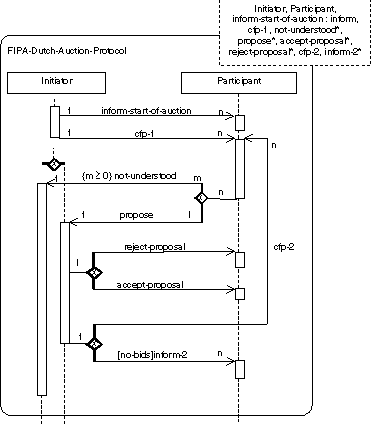FOUNDATION FOR INTELLIGENT
PHYSICAL AGENTS
FIPA Dutch Auction Interaction Protocol Specification
|
Document title
|
FIPA Dutch Auction Interaction Protocol Specification
|
|
Document number
|
PC00032D
|
Document source
|
FIPA TC C
|
|
Document status
|
Preliminary
|
Date of this status
|
2000/11/21
|
|
Supersedes
|
None
|
|
Contact
|
fab@fipa.org
|
|
Change history
|
|
2000/01/28
|
Initial draft
|
|
2000/03/06
|
Updated draft
|
|
2000/06/16
|
Added comments from Lisbon meeting
|
|
2000/10/20
|
Added comments from Sydney meeting; removed cancellable version;
added description of issues with cancellable protocols
|
|
2000/11/21
|
Editorial revision; Submitted to FAB for Experimental
|
© 2000 Foundation for Intelligent Physical Agents - http://www.fipa.org/
Geneva, Switzerland
|
Notice
|
|
Use of the technologies described in this specification may infringe
patents, copyrights or other intellectual property rights of FIPA Members and
non-members. Nothing in this specification should be construed as granting
permission to use any of the technologies described. Anyone planning to make
use of technology covered by the intellectual property rights of others
should first obtain permission from the holder(s) of the rights. FIPA
strongly encourages anyone implementing
any part of this specification to determine first whether part(s)
sought to be implemented are covered by the intellectual property of others,
and, if so, to obtain appropriate licenses or other permission from the
holder(s) of such intellectual property prior to implementation. This specification
is subject to change without notice. Neither FIPA nor any of its Members
accept any responsibility whatsoever for damages or liability, direct or
consequential, which may result from the use of this specification.
|
Foreword
The Foundation for Intelligent Physical Agents
(FIPA) is an international organization that is dedicated to promoting the
industry of intelligent agents by openly developing specifications supporting
interoperability among agents and agent-based applications. This occurs through
open collaboration among its member organizations, which are companies and
universities that are active in the field of agents. FIPA makes the results of
its activities available to all interested parties and intends to contribute
its results to the appropriate formal standards bodies.
The members of FIPA are individually and
collectively committed to open competition in the development of agent-based
applications, services and equipment. Membership in FIPA is open to any
corporation and individual firm, partnership, governmental body or
international organization without restriction. In particular, members are not
bound to implement or use specific agent-based standards, recommendations and
FIPA specifications by virtue of their participation in FIPA.
The FIPA specifications are developed through
direct involvement of the FIPA membership. The status of a specification can be
either Preliminary, Experimental, Standard, Deprecated or Obsolete. More detail about the process of
specification may be found in the FIPA Procedures for Technical Work. A
complete overview of the FIPA specifications and their current status may be
found in the FIPA List of Specifications. A list of terms and abbreviations
used in the FIPA specifications may be found in the FIPA Glossary.
FIPA is a non-profit association registered in
Geneva, Switzerland. As of January 2000, the 56 members of FIPA represented 17 countries worldwide. Further
information about FIPA as an organization, membership information, FIPA
specifications and upcoming meetings may be found at http://www.fipa.org/.
Contents
1 FIPA Dutch Auction Interaction Protocol 1
1.1 Exceptions to
Interaction Protocol Flow. 2
In the FIPA Dutch Auction Interaction
Protocol (IP), the auctioneer attempts to find the market price for a good by
starting bidding at a price much higher than the expected market value, then
progressively reducing the price until one of the buyers accepts the price. The
rate of reduction of the price is up to the auctioneer and they usually have a
reserve price below which not to go. If the auction reduces the price to the
reserve price with no buyers, then the auction terminates.
The term "Dutch Auction" derives
from the flower markets in Holland, where this is the dominant means of
determining the market value of quantities of (typically) cut flowers. In
modelling the actual Dutch flower auction (and indeed in other markets), some
additional complexities occur. First, the good may be split: for example the
auctioneer may be selling five boxes of tulips at price X, and a buyer may
purchase only three of the boxes. The auction then continues, with a price at
the next increment below X, until the rest of the good is sold or the reserve
price met. Such partial sales of goods are only present in some markets; in
others the purchaser must bid to buy the entire good. Secondly, the flower
market mechanism is set up to ensure that there is no contention amongst buyers
by preventing any other bids once a single bid has been made for a good. Offers
and bids are binding, so there is no protocol for accepting or rejecting a bid.
In the agent case, it is not possible to assume, and too restrictive to require,
that such conditions apply. Thus it is quite possible that two or more bids are
received by the auctioneer for the same good. The protocol below thus allows
for a bid to be rejected. This is intended only to be used in the case of
multiple, competing and simultaneous bids. It is outside the scope of this
specification to pre-specify any particular mechanism for resolving this
conflict. In the general case, the agents should make no assumptions beyond
"first come, first served". In any given domain, other rules may
apply.
The representation of this IP is given in Figure
1.

Figure
1: FIPA Dutch Auction Interaction Protocol
This IP is a pattern for a simple
interaction type. Elaboration on this pattern will almost certainly be
necessary in order to specify all cases that might occur in an actual agent
interaction. Real world issues of cancelling actions, asynchrony, abnormal or
unexpected IP termination, nested IPs, and the like, are explicitly not
addressed here.
